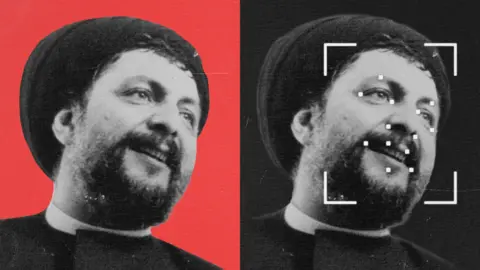Warning: Contains images some may find upsetting
A computer scientist at a university in the north of England is studying an image of a corpse - attempting to solve a mystery that has gripped the Middle East for nearly 50 years.
This is what he looks like now? asks Bradford University's Prof Hassan Ugail doubtfully.
The digitised photo is of a decomposed face and is about to be run through a special algorithm for our BBC investigation.
The original photo was taken by a journalist who saw the body in a secret mortuary in the Libyan capital in 2011 and was told that it could be charismatic cleric Musa al-Sadr, who vanished in Libya in 1978.
Sadr's disappearance has spawned endless conspiracy theories; some people believe he was killed, while others claim he is still alive and being held somewhere in Libya. For his ardent followers, his disappearance holds the same level of intrigue as the 1963 killing of US President John F Kennedy. Such is the sensitivity of our long investigation that my BBC World Service team and I even found ourselves detained in Libya for several days.
Emotions run high because Sadr is so revered by his followers, both for his political reputation, having advocated on behalf of his native Lebanon's then-marginalised Shia Muslims, and as a wider religious leader. His followers gave him the title of imam, an unusual honour for a living Shia cleric.
Sadr's mysterious disappearance resonates deeply with the Shia belief in the "hidden" 12th imam, who, according to Twelver Muslims, is believed to be alive and will return to bring justice to Earth. His fate arguably changed the political landscape of the Middle East, as many believe he was set to steer Iran and the region towards a more moderate direction.
In 2011, Kassem Hamadé, a Lebanese-Swedish reporter, entered a secret mortuary in Tripoli and saw several bodies. He noted that one unusually tall corpse fit Sadr's description. The body showed signs of violence but definitive identification was necessary. Experts at Bradford University utilized facial recognition technology to compare the mortuary photo to images of Sadr throughout his life. The analysis gave a high probability that the body belonged to Sadr.
During a recent trip to Libya to further investigate, the BBC team faced challenges including detainment by Libyan authorities, highlighting the sensitive nature of the inquiry. The ongoing debate regarding Sadr's fate fuels his supporters' beliefs and underscores the complexities entwined with his legacy in Lebanon and the Shia community. As the investigation continues, the possibility of closure looms, with hopes pinned on the findings of the body in the mortuary.



















